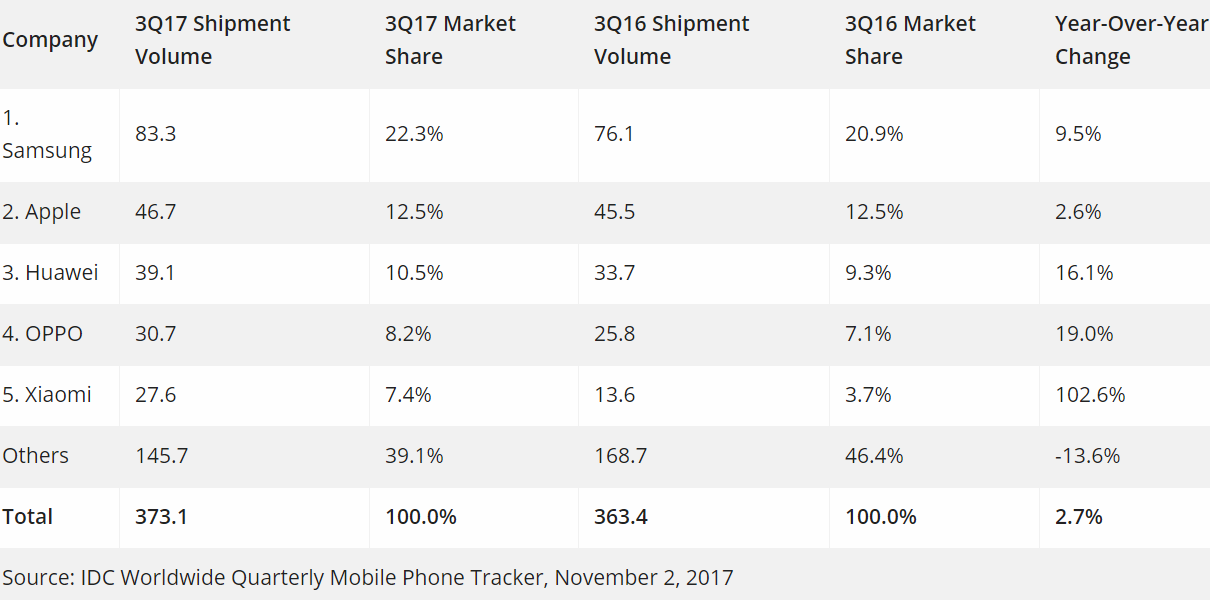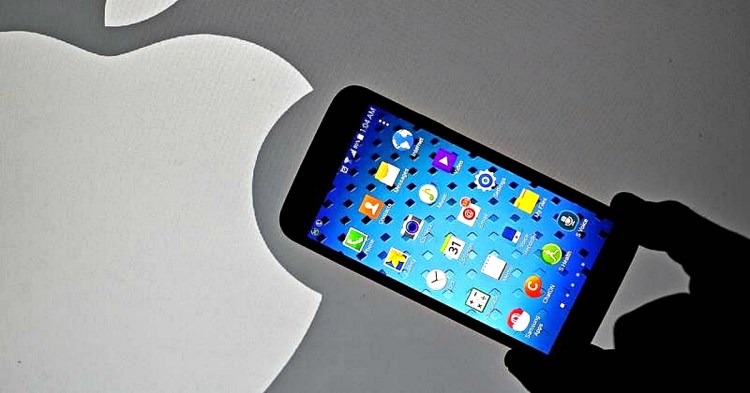After a rare contraction of the smartphone market in Q2 2017, smartphone vendors shipped a total of 373.1 million smartphones worldwide in Q3 2017, up 2.7 percent from the 363.4 million units in Q3 2016. The top five (Samsung, Apple, Huawei, Oppo, and Xiaomi) all shipped more units, and all except Apple gained share as a result.
In Q3 2017, South Korean giant Samsung once again shipped more smartphones than any other vendor. Its American counterpart, Apple, managed to ship just over half of that number, but the gap widened between the two. The Chinese trio each shipped more smartphones than a year ago. The Q3 2017 figures come from IDC, which summarized its findings in the following chart:

As you can see above, Samsung’s market share increased 1.4 percentage points (from 20.9 percent to 22.3 percent) as it shipped 7.2 million more smartphones to reach 83.3 million. Every quarter, Samsung owns about a fifth of the market, and that has remained true for the first three quarters of 2017. The introduction of the Galaxy Note8 went smoothly, and demand has been strong enough for the company to put the Note 7 fiasco behind it. That said, Samsung’s mobile division saw overall revenue decrease as more affordable models, like the J-Series and A-series, were responsible for most of its shipments.
June 5th: The AI Audit in NYC
Join us next week in NYC to engage with top executive leaders, delving into strategies for auditing AI models to ensure fairness, optimal performance, and ethical compliance across diverse organizations. Secure your attendance for this exclusive invite-only event.
Apple, meanwhile, stayed flat at 12.5 percent market share after shipping an additional 1.2 million units to hit 46.7 million. Apple did not benefit much from Samsung’s woes. While the iPhone 8 and iPhone 8 Plus have seen weak demand, all eyes are now on the iPhone X launch. This is not a typical iPhone year: It’s the 10th anniversary, and Apple launched three new phones for the first time to celebrate. The fourth quarter is the company’s most important due to the holiday season, and the jury is still out on how the iPhone X will perform.
Huawei gained 1.2 points (to 10.5 percent), hitting double digits for the second time (the first time was last quarter). That’s after shipping 5.4 million more units than in the quarter a year ago and hitting 39.1 million. The company’s Mate 9 and P10 flagships are pushing the high end, while its Honor brand is making waves on the more affordable side. Huawei is making a big bet on its AI chip to take on Samsung and Apple. Successfully penetrating the U.S. market at the carrier level is the next step.
Oppo increased its share by 1.1 points (to 8.2 percent), and Xiaomi doubled up by 3.7 points (to 7.4 percent). Chinese brands Oppo and Vivo last year pushed out previous fourth- and fifth-place players Lenovo and Xiaomi, but the latter has made a comeback. While the Android and iOS duopoly is only getting stronger, the Samsung and Apple duopoly is eroding as China’s smartphone market matures and local players look to the worldwide stage. Chinese value-packed devices offer the latest features at a fraction of the cost of market leaders Samsung and Apple.
As always, Q4 will be the determining quarter for the year. While 2017 appears to be a rebound year for smartphones, that doesn’t mean there won’t be clear winners and losers.
“As much of the focus has been on the wide range of high-profile flagship smartphones launched or announced in Q3, it is also important to look at what is happening with the rest of the industry,” IDC vice president Ryan Reith said in a statement. “Collectively, the industry continues to grow, but at a much slower pace than past years. What is clear is that the ‘Others’ outside of the top 5 leading vendors continue to struggle and the industry leaders are quickly forming two camps. First, those able to drive significant volumes at the high end, which right now is basically Samsung, Apple, and Huawei, despite high-profile launches from Google, Essential, LG, and others. Second, a few other Chinese OEMs that are making tremendous headway outside of the China domestic market.”

